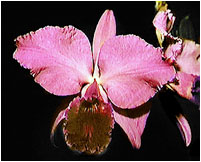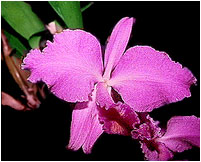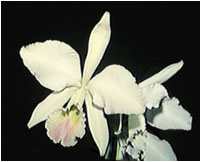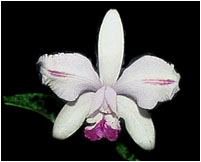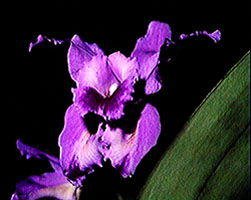 |
Introduction and Definition
What
is an “Anomaly”?
Anomaly
is an accentuated deviation of a normal standard.
When the deviation occurs in a vegetable, this
anomaly is called “Peloria” or “Peloric”.
Peloria - Floral anomaly, quite common
in orchids, consists in a “Zygomorphous”
flower transmuted into “Actinomorphous”
one. |
Zygomorphous
- Kind of floral symmetry where the organ only admits
one plan of symmetry. So it is a bilateral symmetry, it
means, there are median organs and different organs, compelling
to admit a median plan of symmetry. It is, in general,
anther-posterior, not oblique. In other words, it fits
the admitted concept of a perfect flower. In the case
of the orchids, the flower should have 2 petals, a lip
and three sepals;
Actinomorphous - It is said about any organ or part
of a plant that has a radiated symmetry and allows to
trace many plans of symmetry. It is considered as a imperfect
flower, it means, the segments are deformed.
Let us to analyze the occurrence in orchids.
The incidence of anomalies can occur in the floral segments
as well as in the vegetative parts.
Some floral anomalies registered in the horticultural
orchidophilia:
Trilabiate - When the anomaly occurs in the tip
of the petals transmuting them into false lips.
Labeloid - When the anomaly occurs in the inferior
sepals which present the characteristics of the lip. The
superior petal can be wider;
Gamosepalous - when the sepals are united;
Gamopetalous - which the petals are united;
Homochlamydeous - Having a perianth formed by similar
petals and sepals. The
Floral anomalies and the registers in Orchidophilia
During
many years of orchidist, I noticed that some orchids
presenting many anomalies in their floral segments such
as petals transformed in lip; sepals in petals; sepal
in labellum; lack of labellum with an exposed column;
welded segments; distortion of color and many others
aberration.
Among the registered imperfections, many showed a very
special charm and many times forming defects which were
"perfect”.
This work is not a technical one, it aims to register
some mutations with a so exotic beauty that made me
so enthusiastic inducing me to collect data in books
and magazines about those occurrences.
Getting deep in the studies about the "Floral Anomalies”,
I verified that this subject has been already researched
for more than a century.
In "Lindenia”, there is a Cattleya labiata
“Alfrediana” showing the petals and sepals
with some characteristics of the frontal form of the
lip. This occurrence has been attributed to a virus.
Lucien Linden, J.J. Linden's, in his book “Les
Orchidées Exotiques”, edited in 1894, mentioned
some anomalies considered as "aberrations”.
One of the notes concerned the flowers of Paxtonia
-Thelymitra where the lip is similar to the petals,
so that the perianth is composed by 3 petals and 3 sepals.
He also mentioned that another orchids didn't present
roots such as Epipogium gmelinii and Corallorhiza.
He noticed that Corallorhiza, Limodorum,
Neottia (nidus-avis) had no leaves and in
some case they were reduced, like scales.
He mentioned that Reichenbach f. described a species,
Arundina petandra, presenting 3 stamens united
to the gynostemium that had 2 lateral elongated bodies
which were similar to the two another stamens.
This is the reason for the name "petandra”.
Fritz Müller refers to Epidendrum, coming
from Brazil, that had 2 stamens when the normal is three.
At about 1875, Reichenbach f. described an orchid, Masdevallia
muscosa, coming from New Granada, which had a sensitive
particularity. The lip has a kind of crest where is
located its sensibility which is activated at the smallest
contact. When this contact lasts, the lip raises quickly,
throwing against the column. If an insect lays on the
flowers and touches the crest of the lip, it is taken
and enclosed in a prison formed by lip and pressed against
the flower. The insect can just get out by an opening
at the anther, taking the pollinia glued in its body
that, possibility, it will deposit in another flower.
The floral stem and the ovaries are recovered by eyelashes
that avoid creeper insects penetrate the flower.
There are notes about a Cypripedium volonteanum
which presented 3 stamens when the normal is two. The
staminode was replaced by a median stamen.
There are registers done by M. Rolfe, in 1891, that
in M. Raphael's collection, an Epidendrum vitellinum
bloomed with 5 racemes with double flowers. The
lip has been transformed in a common petal and the column
divided into 6 segments, similar to petals that occupied
the center of the flower producing double flower with
12 floral segments.
In face of this occurrence, Lucien Linden referred to
a theory defended by Barbosa Rodrigues.
D. Maxwell T. Master, Director of the “Gardners’
Chronicle” who did deep studies about the Teratology
(the study of monstrosities) mentioned a Laelia pumila
which presented, in the same peduncle, a normal flower
and another with the lip transformed in petal. He also
registered another Laelia that presented the
petals transformed in lip.
In 1897, James Davidson showed a Laelia tenebrosa
'Janus' having a flower with half lip and half petal.
As we saw, those “Floral Anomalies”, monstrosities,
aberrations, mutations or peloric forms served for the
botanists making many hypothesis and theories about
the basic form of the orchids, giving us a priceless
legacy.
Barbosa
Rodrigues, Cattleya intermedia aquinii and another
anomalies
Much has been said about Dr. João Barbosa Rodrigues,
even though, I should be repetitive because we can not
mention "Floral Anomalies" without putting
in evidence this celebrity of the Brazilian Botany born
in 22/6/1842 and died in 6/3/1909.
I n 1884, Dr. João Barbosa Rodrigues found the
Botanical Garden of Manaus - Amazonas directing it until
1890. Then he took the direction of the Botanical Garden
of Rio de Janeiro where he stayed until his death.
In 1877, Barbosa Rodrigues classified the Cattleya
trilabiata which presented normal petals and lips.
The dorsal sepal were wider seeming to be a petal e
the lateral sepals were transmuted into false lips.
This occurrence has been registered in the publication
“Genera et Species Orchidearum Novarum”.
This plant, later reclassified as Cattleya warneri,
was found in 1876, in the surrounding of Lagoa Santa,
in the state of Minas Gerais.
Among his works, the most important is the “Iconografia
de Orquidáceas Brasileiras”.
Dr.
João Barbosa Rodrigues defended a theory that
was, in a certain way, confirmed by the C. intermedia
aquinii.
In 1881, he did a great study about this subject, published
in the “Journal des Orchidées”, deserving
a compliment done by the savant Dr. Eichler, Professor
of Vegetal Morphology at the University of Berlin (some
publications mention - Vienna). In this work, he proved
that, organ-genetically, the normal flower of an orchid,
composed by 6 divisions, was an anomalous flower. In
theory, it should have 24 organs: A calyx with 6 sepals,
a corolla with 6 petals and 12 reproducing-organs.
Let us do a slight recapitulation about the famous C.
intermedia which discovery has been a remarkable
event.
Between 1874/1875, Mr. Antônio J. da Silva Valadares
living in Porto Alegre, in the state of Rio Grande do
Sul, got a great quantity of Cattleya intermedia
coming from the woods. When they bloomed, one blossomed
completely different from the normal flower because
it presented strangulated edges with purple blotches
in the same color of the lip. In face of the great interest
showed by his friend, Mr. Francisco de Aquino, one of
the biggest orchidists of this time, Mr. Valadares gave
it to him. Later, Mr. Aquino did some divisions and
distributed among his friends. He also send one to Dr.
Barbosa Rodrigues who considered it as a new species.
In 1891, he did a drawing and an analytic study about
this Cattleya intermedia and publishing them
in “Plantas Novas Cultivadas no Jardim Botânico
do Rio de Janeiro”.
This C. intermedia knew a great success in England
and was registered, in 1900, in the magazine “Gardners’
Chronicle”. In 1904, it was exhibited for the
first time, in London, by the collector Mr Trevor Lawrence
and was rewarded with a "Merit Certificate".
By this time, it was considered a hybrid, later, it
has been proved that it was a native species. Another
specimens with the same characteristics appeared and
received individualized names.
Nowadays, there is an agreement between the orchidists
that the aquinii is a designation that only can
be applied to the primitive specimen and should use
“aquinada' to identify the peloric form of the
other specimens that have the same characteristics.
When we analyze a C. intermedia aquinada which
presents petals with strangulated edges and purple blotches
(in the same color of the lip), we see that the drawing
fits to the horticultural concept that identifies it
as a- “Peloric -Trilabiate”.
In this species, we also found specimens presenting
the color characteristics but without strangulated petals.
Inside the orchidist concept, this form is identified
as “Flamed”. Strictly, I consider as “Trilabiate”.
Nowadays, we already have the occurrence of this form
in the variety “Caerulea”.
Taking those horticultural concepts of C. intermedia,
aquinada and flamed, we consider its form as inside
the concept of “Floral Anomalies”, mainly,
in face of the variations that we could verify in the
distribution of the color.
Photographical
Illustration of Floral Anomalies
To
illustrate this work, I will present photographical
reproductions of some “Floral Anomalies”
that I observed in the blooming of my orchid collection.
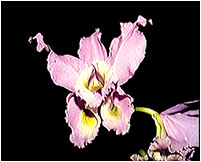 |
C. labiata
'Curinga'
The inferior petals are transmuted into perfect
lips, exactly similar to a true lip, except for
the column. It shows, inside, a dark yellow which
lights up ahead and becoming almost white and
colored by soft lilac. The dorsal sepal is transmuted
into petal. Inside those deformations, it presents
a perfect structure. This anomaly is considered
as a “Labeloid”. |
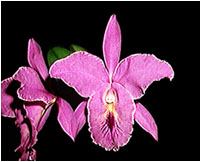 |
C. labiata 'Enjeitada'
Concerning the form, there is nothing to say,
however it presents an anomaly that gives an aspect
completely different. The front of the lip is
totally spread, fleeing of the normal characteristics
and give an emphasized purple blotch in the center. |
| |
|
| C.
labiata 'Mercado'
Analyzing the first flower, we can see a color
in the lip which is not common. It is an 'Atro',
it means, the purple in the front of the lip is
spread for all border reaching the external part
of the tube until the junction of the other segments.
They don't show imperfections. Analyzing the second
flower, we can see that the inferior sepals are
welded and the lip is deformed. The petals and
the superior sepal follow a normal structure.
|
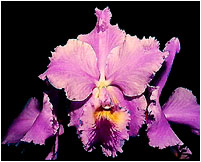 |
C.
labiata 'Crista de Galo'
This flower presents beautiful defects which fit
it inside the concept of “Labeloid”.
Petals without defects. The dorsal sepal transmuted
into petal and the inferior ones are false lips.
The lip doesn't show any alteration. |
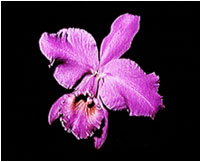 |
C.
labiata
'Carraspana'
In this blooming, this orchids presented a dorsal
sepal much more wider than the lateral ones. I
considered it as a simple floral aberration. There
is not yet another blooming to verify if the defect
will be repeated.
|
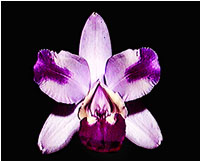 |
C.
intermedia 'Pandora'
I classified this intermedia as 'Flamed'. The
purple blotches in the extremities of the petals
are not strangulated. I considered, inside the
species and the variety, very good. Taking the
adopted concept, it is a "Trilabiate”.
|
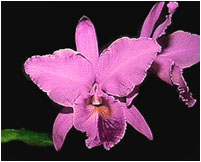 |
C.
labiata 'Porta Estandarte'
If we consider the form, inside the “Lilac”
form, we should say that is good. Wider petals
and united at the superior edges. The sepals are
well placed. When we look at the lip, we see that
the color of the front of a side is completely
defective showing a purple-striate color that
disappears completely in the other side |
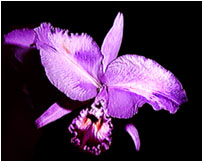 |
C.
warneri
It
is a “Peloric”, known by the orchidists
as a “Trilabiate”. As a “Floral
Anomaly", we couldn't ask for principles
of perfection. Even though it has a good formation.
Its color is very original. |
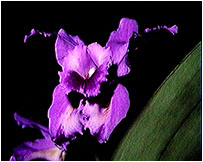 |
C.
labiata
'Odilon'
The
defects of this flowers make us to classify it
as a 'Labeloid'.
The petals and lip do not present deformations.
The dorsal sepal became a petal and the lateral
false lips. “Beautiful flower”. |
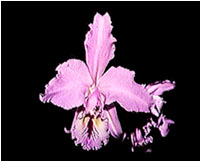 |
C.
labiata 'Conto do Vigário'
We can considered as a 'Labeloid'. The purple
color of the front of the lip is broken by the
purple central vein with veined ramifications.
The lateral sepals present a central vein with
a yellow streak the same color of the interior
of the lip tube, brooking the lilac. The dorsal
sepal presents a widening, almost becoming a petal.
The petals show a normal formation. |
| |
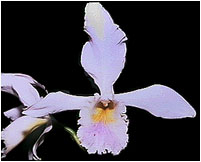
|
| C.
labiata 'Foleyana'
In the first frame, the flower presents normal
characteristics. In the second, we can see a floral
degeneration hard to be identified. The superior
segment id formed by the aggregation of the petals
with the dorsal sepal. The lateral segments concern
the lateral sepals. The lip doesn't show any defect
nor in its structure neither in the color. |
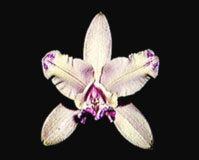 |
C.
intermedia 'Bandaleon'
The
flower shows the deformed extremities of the petals,
with a peculiar strangulation of the the 'aquinadas'.
However the drawing presented differ from the
traditional color. In the extremities, it shows
just small dark purple strokes (in the same color
of the lip). The sepals have a perfect structure
and are well triangulated. |
| |
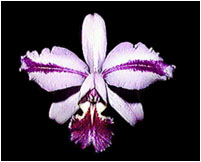
|
| C.
intermedia
'Cara de Gato'
I have difficulties to determinate the classification
of this "intermedia". The purple blotch
of the petals, which starts as it was a “Flamed”
(because it is not strangulated), spreads through
the central vein of the petals as a "striated".
Let us forget the polemics and enjoy the very
beautiful flower.
Notice another blooming where the blotches of
the sepals present a small streak, with out the
characteristics of the basic color.
I ask: How to classify? “Maculata”,
“Flamed” or “Striated”
? |
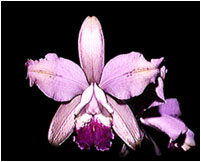 |
C.
intermedia ' Brazão'
As an 'intermedia', it is excellent. Round petals
covering the sepals show a good structure. The
lip is perfect. This flower shows an anomaly in
the petals where we can see a golden yellow streak,
the same color of the interior of the tube, going
through the central vein. As the tips are not
strangulated, I considered it as a “Flamed”.
|
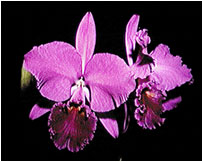
Normal
blooming |
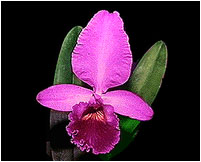
Anomalous
blooming |
Cattleya
labiata 'Schuller'
As
“Rubra”, it always deserved a special
place in any collection. Its color is very dark
purple and has a medium size. The petals are round
and united at the superior edges. The front of
the lip is completely purple.
The second one is a completely different blooming
showing a anomaly where the petals are welded
with the dorsal sepal.
The inferior petals grew up taking the place of
the petals. The lip is normal. Even inside this
imperfection, it is out standing. |
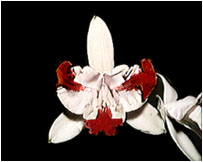 |
Cattleya
intermedia 'Chapeuzinho Vermelho'
This "intermedia" shows in the tips
of the petals, a strangulation recovered with
a purple color as there is in the front of the
lip. That identifies it as a "aquinii"
Considering this aberration, its form is very
good. It deserves a special place as a representative
of this anomaly. |
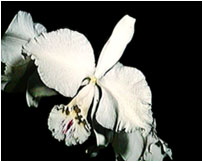
Normal blooming |
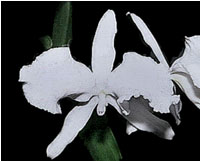
Anomalous blooming |
| Cattleya
warneri '
Itabirana'
This is a traditional warneri - semi-alba. The
first one is a flower with a normal structure.
Considering the species and its color form, it
stands out. The segments are white showing a solferin
and ramified vein in the front of the lip.
The second one has normal sepals and petals but
we notice the lack of the lip, showing just the
column. |
Any
kind of reproduction (print, digital or anyone) of any type of
material of this site: texts, layout, photos, images and others
- is
strictly forbidden without previous written permission of the
authors. All rights reserved. Any solicitation or information
by the e-mail: bo@sergioaraujo.com |
|



